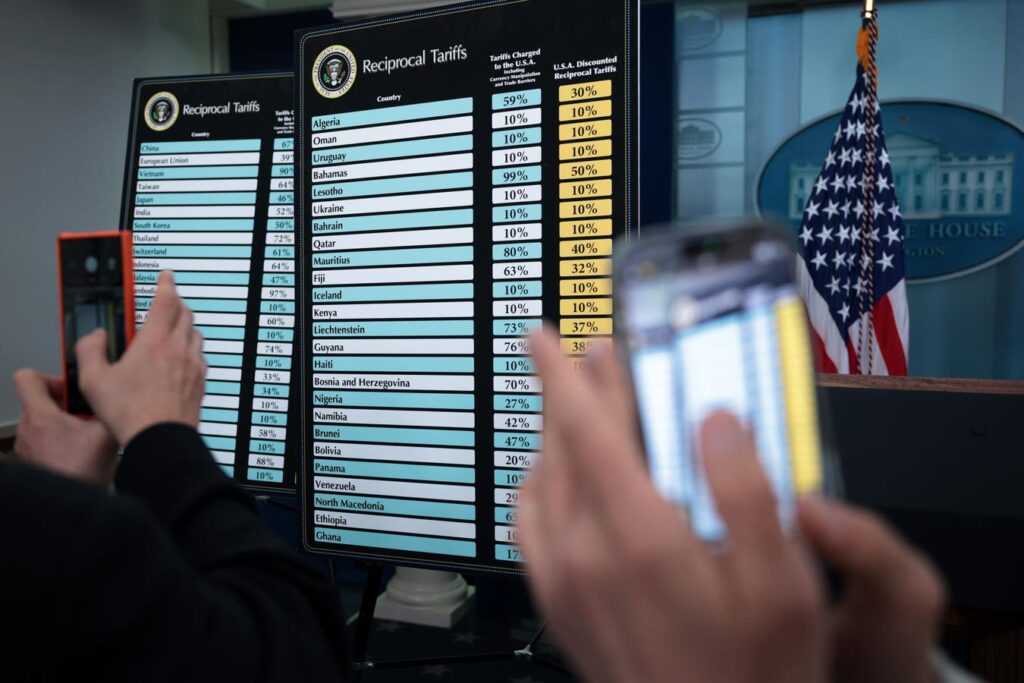When President Donald Trump announced a new round of tariffs on April 2nd, small business owners were quick to start doing the math. It didn’t take much figuring. Prices would have to go up.
The tougher calculation is how to explain that to customers who have already endured years of steep price hikes after decades of relative calm.
One idea making the rounds: Break out the new Trump tariff on the invoice or receipt and show people what’s driving the hike (and, maybe, to prove they aren’t trying to use the tariff as a way to slip a little extra in to boot). It’s one way businesses are trying to soften what could be serious sticker shock and, outside of eating the price hikes, maybe the only thing they can do. Big companies are weighing it too, of course. For example, German automaker Volkswagen is adding an “import fee” line item to its vehicles. “We want to be very transparent about navigating through this time of uncertainty,” a spokesperson for Volkswagen told the Wall Street Journal.
There’s a good debate happening on Reddit about it. One user said they plan to show tariffs right on the receipt: “Product X: $100. Sales tax: $6. Shipping: $12. Tariff: $24.” Supporters say it helps make the case that higher prices are not the business’s fault. But it gets tricky. Most small businesses don’t import goods themselves, and even for those that do, figuring out which products are hit and by how much can be hard to pin down.
Feasibility aside, this idea of breaking out your costs isn’t new. Economists call it “cost transparency.” The idea is that when a business shows what something costs to make, customers may be more likely to trust that the price is fair. But it’s a delicate balance. Companies are often reluctant to reveal margins, and some customers may prefer to remain in the dark about the markups the are paying. Revealing the tariff related price in granular detail would, for those willing to do the math, unveil the part of the cost of the goods from the supplier.
Brands like Everlane, for example, have tried it with mixed results. The company built its identity around “radical transparency,” showing customers how much each item costs to make. But critics have said it was more branding than substance.
A 2014 Harvard Business School paper called Lifting the Veil: The Benefits of Cost Transparency looked at what happens when companies show customers their expenses. The authors—Bhavya Mohan, Ryan Buell, and Leslie John—found that it can build trust and even boost sales (the paper used Everlane as an example). When customers saw that a shirt cost $8 to make and was priced at $30, they were more likely to buy it than if they were just shown the $30 price. It made people feel like the company was being straight with them.
But the study also notes a catch. Cost transparency works best when customers already feel a connection to the brand. If the relationship is purely transactional, showing the numbers might actually backfire. Instead of building trust, it can raise doubts about whether the figures are real.
That tracks with what small business advisors are seeing on the ground.
Makena Finger Zannini, founder and CEO of The Boutique COO, a Portland, Oregon-based firm offering business growth strategies and support services to entrepreneurs and small business owners, says whether to disclose tariffs depends on the business and its relationship with customers. For some, transparency fits naturally with how they already operate. But for most, she says, a general note about rising prices will suffice.
“You can frame it as ‘costs are up,’ because frankly costs are up,” Finger Zannini says. “I don’t see a lot of small businesses disclosing this to the dollar and the cent.”
That’s how Lou Mosca sees it, too.
Mosca, chief operating officer of Orlando-based American Management Services, a firm that advises small and mid-sized businesses on operations and profitability, says spelling out tariff costs is usually a bad idea. He says most customers already know prices are going up and that calling out tariffs in detail can do more harm than good. He too thinks a simple disclaimer is enough. Anything more just gives customers more room to push back.
“Transparency can sometimes bite you in the you know what,” Mosca says. “If you’re selling to gigantic box stores where they’ve already beaten you down on pricing, transparency will just give them more leverage.”
Something else to keep in mind, tariffs, and these tariffs in particular, aren’t neutral. They’re political. And if a business calls them out in its pricing, some customers might read it as taking a side. That could help or hurt, depending on the customer base.
To be sure, not all small business owners are fretting about the tariffs. Some support them outright. Surveys, such as Guidant Financial’s 2025 Small Business Trends report, show nearly half of small business owners identify as Republican, compared to just 17 percent who say they’re Democrats.
MORE FROM FORBES
Read the full article here











